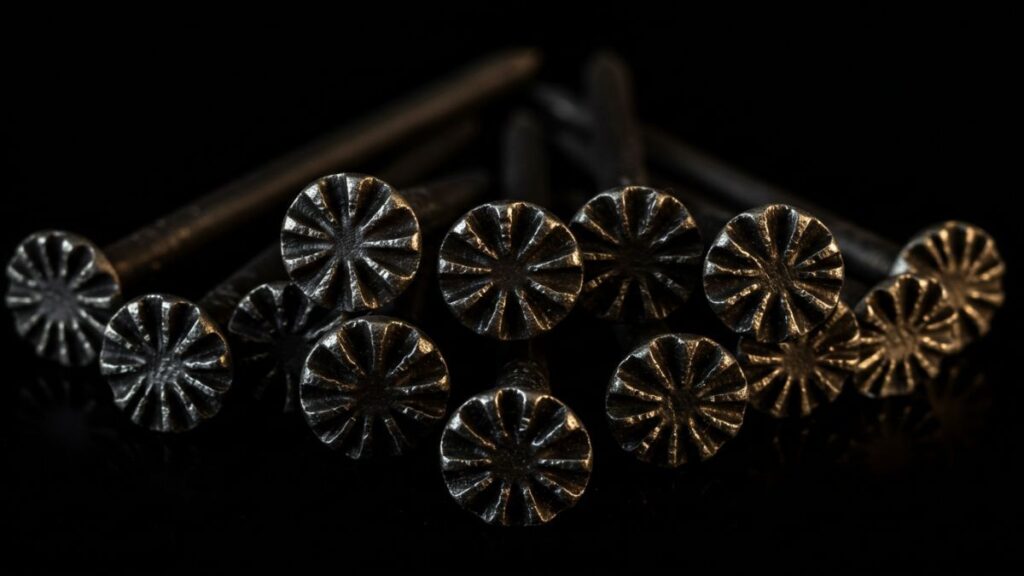What Are Rosehead Nails
Rosehead nails are traditional fasteners characterized by their distinctive large, flat, and roughly square heads resembling a rose. These nails date back centuries and were commonly used before the invention of modern wire nails. Their rustic appearance and strong hold make them highly sought after for restoration projects, antique furniture repairs, and historical building reconstructions.
Craftsmen and builders admire rosehead nails for their durability and the authentic vintage aesthetic they impart. Whether working on a colonial home restoration or crafting period furniture, rosehead nail’s bring an unmatched historical authenticity to any project.
A Brief History of Rosehead Nails
The story of rosehead nails is deeply intertwined with the development of metalworking and construction. Before industrialized nail production, blacksmiths individually hand-forged nails. Each nail had a unique appearance, with the distinctive rose-shaped head formed by hammering the top flat.
During the 18th and early 19th centuries, rosehead nail’s were standard in construction across America and Europe. They held together everything from barns and cabins to fine furniture and ships. Their historical importance makes them essential for accurate historical restorations today.
As machine-made nails became common in the mid-19th century, the need for hand-forged nails declined. However, rosehead nails never truly disappeared. Artisans, restoration experts, and traditional builders continue to value them for their superior holding power and aesthetic appeal.
Common Uses of Rosehead Nails
Rosehead nails are not just relics of the past; they remain highly functional and stylish for a range of projects today. Their typical uses include:
- Historical Restorations: Restoring old homes, furniture, and other period pieces demands authentic materials. Rosehead nails match the look and strength of original construction methods.
- Furniture Making: Traditional furniture makers use rosehead nail’s to build or replicate pieces in historical styles, adding beauty and durability.
- Boat Building: Some wooden boat builders prefer rosehead nail’s for fastening planks and frames due to their strong hold.
- Architectural Millwork: Rosehead nail’s secure large trim pieces, wooden panels, and other detailed woodworking in historic restorations.
- Decorative Applications: Designers and hobbyists use these nails for a rustic or vintage look in home décor, including exposed beams, accent walls, and art installations.
Their unmistakable charm enhances any project that calls for authenticity and craftsmanship.
Advantages of Using Rosehead Nails
Choosing rosehead nails offers several practical and aesthetic benefits:
- Exceptional Holding Strength: The square shaft of rosehead nail’s bites into wood fibers, providing a strong grip less likely to loosen over time.
- Durable Construction: Forged from high-quality steel or iron, rosehead nail’s resist bending and shearing.
- Authentic Appearance: The distinctive rose-shaped head adds historical and visual authenticity to woodworking and restoration projects.
- Corrosion Resistance: Many rosehead nail’s are coated or made from corrosion-resistant materials, ideal for outdoor or marine applications.
- Craftsmanship Appeal: Their handmade look adds character and story to any construction or artistic project.
These qualities make rosehead nails a preferred choice for builders who appreciate tradition, strength, and beauty.
Curious to learn more? Dive into the rest of our blog for helpful tips and insights!
Materials and Finishes Available
Rosehead nails come in several material options and finishes to meet the needs of different projects:
- Wrought Iron: Traditional blacksmiths often forge rosehead nail’s from wrought iron, giving them a historic look and excellent strength.
- Steel: Modern versions typically use steel, sometimes coated for corrosion resistance.
- Galvanized Steel: A zinc coating makes these nails suitable for outdoor use by preventing rust.
- Antique Finishes: Some nails are treated to look aged, blending seamlessly with existing historic structures or furniture.
- Brass or Bronze: For certain decorative projects, brass or bronze rosehead nails provide an elegant, polished look with natural corrosion resistance.
Choosing the right material ensures the nail complements the project’s function and style while maximizing durability.
How to Choose the Right Rosehead Nails
Selecting the right rosehead nail’s for your project requires considering a few key factors:
- Project Type: Restoration work may require historically accurate wrought iron nails, while decorative projects can use brass or antique-finished versions.
- Nail Size: Longer nails offer stronger holds for heavy timber, while smaller nails suit delicate furniture or trim work.
- Material Compatibility: Ensure that the nail material matches or complements the wood or metal being fastened to prevent corrosion or staining.
- Aesthetic Requirements: Consider the visible look of the nail head. Hand-forged nails vary slightly in appearance, offering a more authentic finish.
- Budget: Handmade and custom nails typically cost more than mass-produced versions, so factor cost into your decision-making.
Careful selection ensures the nails will both perform and appear as intended, preserving the integrity and beauty of the work.
How to Properly Use Rosehead Nails
To achieve the best results when working with rosehead nail’s , follow these practical tips:
- Pre-Drilling: For hardwoods or precision work, pre-drill a pilot hole slightly smaller than the nail shaft to prevent splitting the wood.
- Hammering Technique: Use firm, straight blows to drive the nail securely. A lighter touch near the end helps seat the rose head evenly against the surface.
- Setting the Nail: You can leave the nail slightly proud (above the surface) for a decorative look, or countersink it carefully if desired.
- Finishing Touches: Some projects may call for peening (hammering) the tip over on the reverse side for extra holding strength, especially in boat building or heavy construction.
Mastering these techniques ensures your project benefits fully from the strength and beauty of rosehead nails.
Where to Buy Quality Rosehead Nails
Finding high-quality rosehead nails is crucial for a successful project. Some reliable sources include:
- Specialty Hardware Stores: Some brick-and-mortar stores carry historical building supplies, including rosehead nails.
- Online Retailers: Websites specializing in woodworking, restoration supplies, or boatbuilding often offer a variety of options.
- Blacksmiths and Artisans: For authentic, hand-forged nails, contact blacksmiths who specialize in traditional methods.
- Auction Sites: Occasionally, antique or vintage rosehead nail’s surface on auction sites, perfect for meticulous restoration work.
Always verify the quality and material of the nails before purchasing, especially for critical restoration projects where authenticity matters.
Modern Alternatives to Rosehead Nails
Although rosehead nails are ideal for many projects, some modern alternatives may suit certain applications:
- Cut Nails: Machine-cut nails offer some of the same holding strength and old-world charm but are generally easier to find and less expensive.
- Wire Nails with Decorative Heads: For purely aesthetic purposes, wire nails with stylized heads may suffice.
- Hidden Fasteners: Some modern builders opt for screws or hidden fasteners to maintain a clean look while ensuring structural integrity.
Understanding these alternatives can help you balance historical accuracy with project demands and budget constraints.
Caring for Structures Built with Rosehead Nails
Projects using rosehead nails require occasional maintenance to preserve their integrity and appearance:
- Inspection: Periodically check nails for signs of corrosion, loosening, or damage, especially in outdoor or marine environments.
- Cleaning: Clean surfaces gently with a soft cloth to remove dirt or moisture buildup that could promote rust.
- Sealing: Wood treated with a protective sealant helps prevent moisture penetration that can lead to nail corrosion.
- Replacement: Replace damaged or corroded nails promptly to maintain structural integrity and appearance.
Proper care extends the life and beauty of structures and items built with rosehead nail’s , preserving your investment and craftsmanship.
Conclusion
Rosehead nails are more than simple fasteners — they are a bridge to history, craftsmanship, and authenticity. Whether restoring a centuries-old home, crafting heirloom-quality furniture, or creating rustic decor, rosehead nails offer durability, visual appeal, and a tangible connection to traditional building methods. Their unique charm and unmatched strength continue to make them a staple among artisans, builders, and designers who appreciate the timeless beauty of well-made work.
Choosing the right rosehead nail’s and using them properly ensures your project will not only endure but also tell a story of heritage and skill. By honoring the craftsmanship of the past, you contribute to the enduring legacy of quality, beauty, and tradition.
Expand your knowledge and check out more posts on our blog!
FAQs About Rosehead Nails
What makes rosehead nails different from modern nails?
Rosehead nails have a distinctive rose-shaped head and are often hand-forged, offering a historical aesthetic and superior holding strength compared to modern wire nails.
Are rosehead nails good for outdoor use?
Yes, especially if they are made from galvanized steel or treated with corrosion-resistant coatings to withstand weather conditions.
Can rosehead nails be used in furniture making?
Absolutely. They are ideal for antique reproductions, rustic furniture, and any project where an authentic, historic look is desired.
Where can I buy authentic rosehead nails?
You can find them at specialty hardware stores, online retailers, artisan blacksmiths, and sometimes at auctions offering antique building materials.
How do I prevent wood from splitting when using rosehead nails?
Pre-drilling a small pilot hole before nailing into hardwood or delicate pieces can help prevent the wood from splitting.







